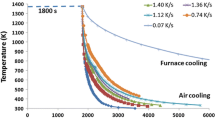Conclusions
-
1.
The optimum content of vanadium in austenitic 0.4 C-4 Cr-18 Mn-V steel, guaranteeing the most desirable combination of strength and ductility characteristics upon aging, is 1.2–1.5%.
-
2.
The primary mechanism of strengthening during the aging of this alloy is the precipitation of vanadium carbide, VC. The optimum aging temperature is 650°C.
-
3.
The maximum level of strength attained upon aging rises with increasing quenching temperature from 1050 to 1175°C.
-
4.
After quenching from 1100°C and after the optimum aging treatment at 650°C, the following properties are typically obtained: ultimate tensile strength, 100–110 kg/mm2; yield strength (0.2% offset), 75–80 kg/mm2; elongation, 35–45%; reduction in area, 40–50%.
Similar content being viewed by others
Literature cited
V. G. Gorbach et al., in: Technology of Heavy Machine Building [in Russian], NIITyazhmash of the Uralmashzavod, Sverdlovsk (1961).
V. G. Gorbach et al., MiTOM, No. 1 (1964).
M. N. Koslov et al., Zavod. Lab., No. 3 (1963).
V. M. Blinov et al., MiTOM, No. 5 (1970).
Additional information
Institute of Physics of Metals, Academy of Sciences, USSR. Translated from Metallovedenie i Termicheskaya Obrabotka Metallov, No. 6, pp. 60–62, June, 1971.
Rights and permissions
About this article
Cite this article
Uvarov, A.N., Malyshev, K.A., Mirmel'shtein, V.A. et al. Influence of vanadium on the strengthening of 0.4% C-4% Cr-18% Mn austenitic steel during aging. Met Sci Heat Treat 13, 510–512 (1971). https://doi.org/10.1007/BF00656954
Issue Date:
DOI: https://doi.org/10.1007/BF00656954




